Kingdom Animalia Clade Dinosauria Family †Noasauridae Phylum Chordata Order Saurischia | Class Reptilia Suborder Theropoda Subfamily †Elaphrosaurinae Rank Genus | |
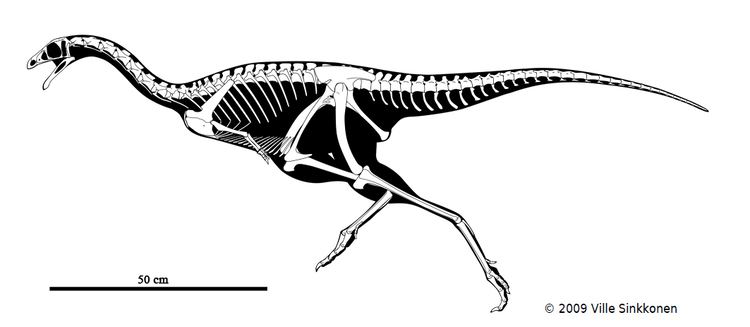 | ||
Similar Ceratosauria, Elaphrosaurus, Theropods, Deltadromeus, Spinostropheus | ||
Limusaurus (meaning "mud lizard") is a genus of theropod dinosaur from the Jurassic (Oxfordian stage) Upper Shishugou Formation in the Junggar Basin of western China. The genus contains a single species, L. inextricabilis. Limusaurus was a small, slender animal, about 1.7 metres (5 ft 7 in) in length, that had a long neck and legs but also highly reduced forelimbs. It underwent a drastic morphological transformation as it aged; while juveniles were toothed, these teeth were completely lost and replaced by a beak with age, corresponding to a shift in diet from omnivory to herbivory.
Contents
- DescriptionEdit
- ForelimbsEdit
- Growth sequenceEdit
- Discovery and namingEdit
- ClassificationEdit
- PaleobiologyEdit
- Evolutionary convergenceEdit
- Development of the beak and feeding ecologyEdit
- Digit homologyEdit
- Taphonomic implicationsEdit
- PaleoecologyEdit
- References

Limusaurus is the first definitively known ceratosaur from Eastern Asia; while originally considered to be the most basal members (i.e. phylogenetically closest to the origin) of the group Ceratosauria along with its closest relative, Elaphrosaurus, a 2016 analysis showed that they are in fact members of the Noasauridae, a group of similarly small and lightly-built abelisaurs. The pattern of digit reduction in Limusaurus has been used to support the contested hypothesis that the three-fingered hand of tetanuran theropods is the result of the loss of the first and fifth digits from the ancestral five-fingered theropod hand, which has implications for the evolution of birds. However, it is now considered to be irrelevant to the subject of digit homology.
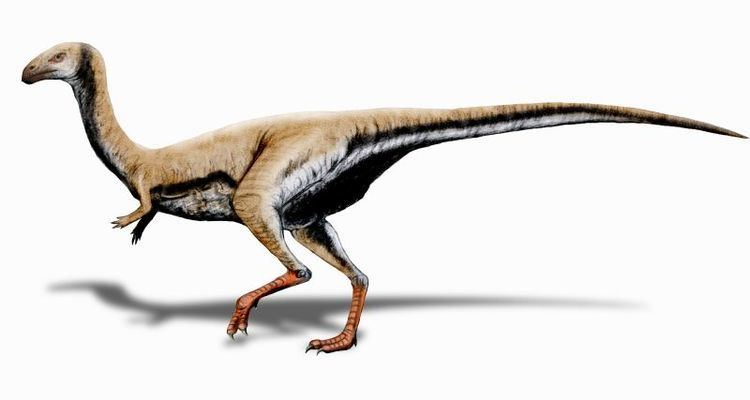
DescriptionEdit
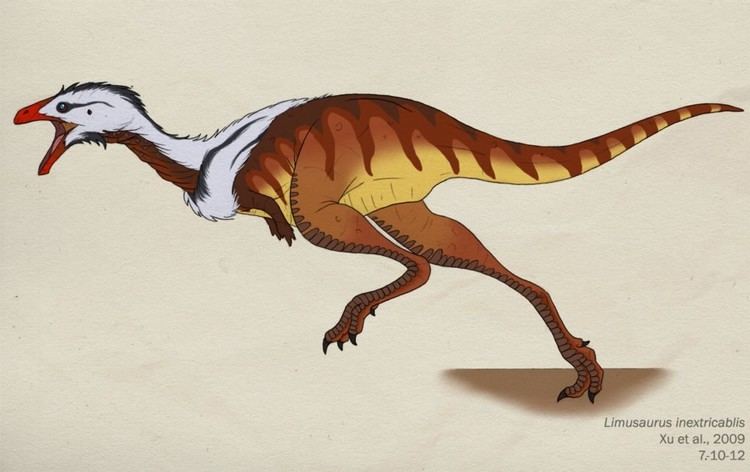
Limusaurus was a small, slender animal with a long neck and legs (the latter being 1.8 times the length of the torso), measuring about 1.7 metres (5 ft 7 in) in length and 15 kilograms (33 lb) in weight. It had a short skull, which was roughly half the length of the femur. A beak covered the slightly convex premaxilla at the tip of the jaw, a feature that was not known in any non-coelurosaurian theropods until the discovery of Limusaurus. The opening, or fenestra, of the mandible was quite large, being 40% the length of the entire lower jaw. The eye socket was also quite large. Other bones with distinctive morphologies in the skull of Limusaurus are the nasal bones, which were ridged on each side, and were short and wide relative to the entire skull; the lacrimal bones, which sloped downwards sharply over the eyes; and the jugal bones, the branches of which were slender and rod-like.

In Limusaurus, the sternum was fused into a single, large, continuous plate, another feature that represents evolutionary convergence upon coelurosaurs. It also possesses a furcula, or wishbone, which previously was unknown among ceratosaurians. Distinctively, the scapula bore a prominent ridge at its front end, and the "boot" of the pubis pointed backwards in a hook-like shape and had a ridge on each side. The legs of Limusaurus had proportions that were well-adapted to running, with the lower portions of the leg being much longer than the femur; the tibiotarsus, the fusion of the tibia and tarsal bones, was 1.2 times the length of the femur, and the foot was 1.3 times the length of the femur. The first toe on each foot, or the hallux, was extremely reduced, being only 17% the length of the third metatarsal; the metatarsals of the other three toes were arranged in an arc, with the fourth metatarsal adhering tightly to the third for its entire length.
ForelimbsEdit
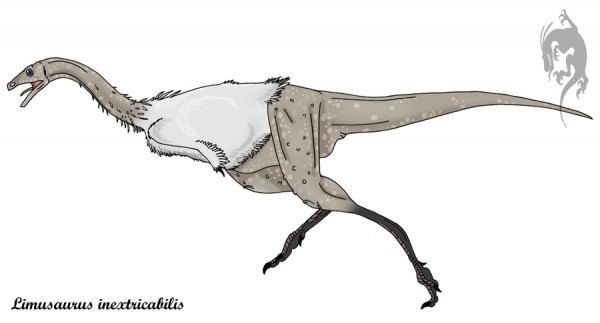
Like other abelisaurs where material from the forelimbs is available, the arms and hands of Limusaurus were considerably reduced, even more so than that of Ceratosaurus. The first finger was smaller than the other fingers and lacked digits entirely. As for the other fingers, the second finger was very robust and had three digits, the third finger only had three digits as opposed to four in other early theropods, and the preserved portions of the fourth finger indicate that it was comparatively long and slender, terminating in a single digit. The claws were short, stout, and expanded at their base.
Growth sequenceEdit
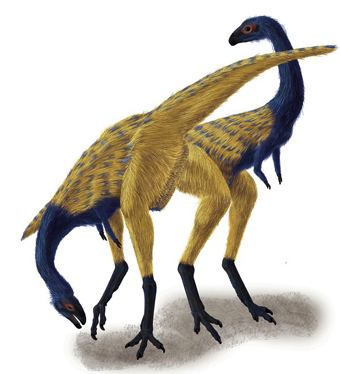
Specimens of Limusaurus show 78 different anatomical changes that occurred as the animals grew. In particular, their heads become shallower, their middle hand bones lengthened, and the "hook" of their pubis grew longer. Additionally, the shaft of the quadrate bone in the skull straightened in adults, and the tips of their lower jaws became more downturned.
The most obvious change that happened during the growth of Limusaurus is the complete loss of teeth from juveniles to adults. Juveniles began with one tooth in the premaxilla, eight in the maxilla, and eleven in the lower jaw (42 teeth total). At the next stage, the first, sixth, and eighth teeth in the maxilla, as well as the sixth in the lower jaw have all been lost (34 teeth total), although the sockets are still present, and there is a small replacement tooth in the socket of the sixth lower tooth. During this stage, usage of teeth and normal tooth replacement likely ceased or became reduced, since none of the still-erupted teeth bear any marks of wear or resorption. As the specimens grew, the transformation became more radical. In subadult and adult specimens older than one year in age, all of the teeth are missing. CT scanning shows that only five empty tooth sockets remain in the adult maxilla; all of the sockets in the lower jaw have fused into a single, hollow canal, and the rest of the tooth sockets have been obliterated.
Discovery and namingEdit
Limusaurus was described in a 2009 paper authored by Xu et al. in the journal Nature. The description incorporated data from two subadult specimens found in close association: the holotype, IVPP V 15923, is an almost complete articulated (i.e. with the bones laid out as they were in life) skeleton; and the other, IVPP V 15304, is a likewise almost complete articulated specimen, only missing the skull. The second specimen is 15% larger than the holotype. These specimens have also respectively been referred to by the erroneous specimen numbers IVPP V 15924 and IVPP V 16134.
Seventeen additional specimens were described in 2016. These specimens are known from three different aggregations (numbered TBB 2001, TBB 2002, and TBB 2005), with the former two being at the same level and the latter some 6.5 metres (21 ft) higher in the stratigraphic column; they include six juveniles (1 year in age or less), ten subadults (2–6 years in age), and one adult (more than 6 years in age). Like the holotype and second specimen, the new specimens are also stored at the Institute of Vertebrate Paleontology and Paleoanthropology. All of the above specimens were recovered during excavations between 2001 to 2006 at the Wucaiwan locality in the Shishugou Formation, located in the Junggar Basin of Xinjiang, China.
Both the genus name, Limusaurus (meaning "mud lizard"), and the name of the type species, L. inextricabilis (meaning "impossible to extricate"), refer to how the known specimens appeared to have died and become preserved after being mired in mud pits.
ClassificationEdit
Limusaurus is a member of the Ceratosauria that shares characteristics with both coelophysoids and tetanurans. The features present in Limusaurus are suggestive of a close relationship between the clades Ceratosauria and Tetanurae. A number of features allow it to be distinguished as a ceratosaurian; these include the tall skull and small antorbital fenestra, the maxilla forming part of the nostril, the nasal enclosing the antorbital fenestra on its back margin, the large mandibular fenestra and relatively short dentary compared to the rest of the jaw, the bulging head of the humerus as well as the long and angled deltopectoral crest, the lack of ossified wrist bones, the large and expanded "boot" of the pubis, and the two grooves on the sides of the foot claws.
Limusaurus was originally described as a basal ceratosaurian, with both it and Elaphrosaurus being recovered as the most basal ceratosaurians in various phylogenetic analyses. However, subsequent research has placed it in the more derived group Abelisauroidea, specifically as a member of the Noasauridae. The following cladogram is based on the phylogenetic analysis conducted by Rauhut and Carrano in 2016, showing the relationships of Limusaurus among the noasaurids; CCG 20011 represents an as-of-yet unnamed taxon formerly referred to the tetanuran Chuandongocoelurus.
PaleobiologyEdit
Histological analysis of the lines of arrested growth within the tibiae from the various ontogenetic stages of Limusaurus indicates that the animal was skeletally mature at six years in age. In older specimens, the outermost lines of arrested growth are very close together (forming what is known as the external fundamental system), indicating that rapid growth had ceased in these particular individuals.
Evolutionary convergenceEdit
Limusaurus has several features of the head in common with basal theropods such as other ceratosaurs and coelophysoids, but it also convergently shares a number of traits, including the beak and the fused sternum, with the later coelurosaurs. The overall aspect of the animal, including the long neck and legs, is very similar to that of the Cretaceous ornithomimid theropods, as well as the Triassic non-dinosaurian archosaur Effigia, representing a significant case of convergent evolution among these three distinct groups of archosaurs.
Development of the beak and feeding ecologyEdit
The loss of teeth with age in Limusaurus is the most extreme case of tooth morphology changing with age among dinosaurs. In fact, Limusaurus is one of the only known jawed vertebrates where teeth are completely lost during ontogeny (the others are the red mullet and striped red mullet, several armored catfish, and the platypus). Its complicated pattern of losing teeth from both the front and the back is most similar to that of the avialan Jeholornis. The temporary halt in tooth replacement likely results from the replacement tooth buds regressing, as in the veiled chameleon. Combined with the retention of the developmental signal pathways necessary to induce tooth development in birds, the ontogenetic replacement of teeth by a beak in Limusaurus suggests that the development of beaks in other lineages of theropods, and indeed beaked animals in general, may be related to developmental changes that heterochronically alter the point at which tooth development halts.
Adult specimens of Limusaurus show morphological traits associated with herbivory that are shared with other groups of herbivorous theropods, including the Ornithomimosauria, Therizinosauria, Oviraptorosauria, and Alvarezsauroidea, along with the troodontid Jinfengopteryx. In particular, adult specimens are characterized by the presence of stomach stones (gastroliths), with older adults had gastroliths that are larger and more numerous than those of younger adults; the size and quantity of these gastroliths are comparable to those of birds in young adults, and those of ornithomimosaurs and oviraptorosaurs in old adults. These groups of theropods all used gastroliths in processing plant matter, suggesting that Limusaurus did the same; the increased amount of gastroliths in older adults may be indicative of the gut's ability to finely process plant matter increasing with age. An isotope analysis of the available specimens of Limusaurus specimens likewise showed that adults consistently match the isotope signatures of other herbivorous dinosaurs; however, in the same analysis, juveniles and subadults were found to vary greatly in their isotopic signatures. This indicates that juveniles were likely omnivorous, but switched to strict herbivory as they aged. This is comparable to the diet shift experienced by the aforementioned mullets and armored catfish.
Digit homologyEdit
The most basal theropods have five digits on the hand. Along the avian lineage, however, the number of digits in the hand decreased; by the emergence of the group Tetanurae, which includes birds, two digits had disappeared from the hand, leaving three digits. Traditionally, it has been hypothesized that the digits lost were the two outermost digits, i.e. digits IV V), in a process known as Lateral Digit Reduction (LDR).
However, the hypothesis of LDR is in contradiction to some embryological studies on birds which show that, from five developmental sites, the digits that develop are the three middle digits (II, III, IV). This inconsistency has been a matter of debate for almost 200 years, and has been used by Alan Feduccia to support the controversial hypothesis that birds are descended not from theropods but from some other group of archosaurs which had lost the first and fifth digits. To explain the discrepancy between morphological and embryological data in the context of bird origins, an alternative scenario to LDR was developed by Tony Thulborn and Tim Hamley in 1982. In this scenario, the digits I and V of theropods were reduced in the process of Bilateral Digit Reduction (BDR), with the remaining digits developing to resemble the former digits I-III. Limusaurus was initially considered as evidence for the BDR hypothesis due to it - and other ceratosaurians - having a reduced first digit, with researchers hypothesizing that a similar pattern of reduction occurred among the tetanurans (the sister group of the ceratosaurians).
Several additional hypotheses have been proposed to improve upon and reconcile the LDR and BDR hypotheses. One predominantly favored hypothesis, first developed by Günter P. Wagner and Jacques Gauthier in 1999, involves a "frameshift" of the digits; the first digit fails to grow in the first developmental site due to not receiving the necessary signals, which has the effect of shifting digits I-III to the positions of II-IV. Thus, while digits I-III from the ancestral theropod are retained, they do not grow in the same location. A version of the frameshift hypothesis modified to incorporate both elements of BDR and fossil evidence from Limusaurus and other theropods, the "thumbs down" hypothesis of Capek et al., suggests that this frameshift took place after the reduction of both the first and the fourth digits in the theropod lineage. The major alternative hypothesis supported by Xu Xing et al., known as the "lateral shift hypothesis", considers a partial, step-wise frameshift in which, from a four-fingered hand with reduced digits I and IV, I fully disappears while IV develops into a fully-fledged finger, with II-IV taking on the morphologies of the former I-III.
It is plausible that ceratosaurians underwent BDR independent of the tetanurans, and therefore has no bearing on the issue of avian digit homology. In particular, as demonstrated by teratological analysis, the abbreviation (mesomelia) and loss of digits (hypophalangia) in the forelimb of Limusaurus is likely the result of a developmental anomaly that appeared exclusively in and persisted throughout the evolutionary lineage of ceratosaurians, and is unconnected to the pattern of digital reduction and frameshift that occurred in tetanurans. This is supported by the hands of the ceratosaurians Ceratosaurus, Berberosaurus, and Eoabelisaurus having plesiomorphic (i.e. more similar to the ancestral condition of theropods than to derived abelisaurs) metacarpal bones comparable to those of the more basal theropod Dilophosaurus. The divergent developmental pathways of ceratosaurians and tetanurans is associated with a difference in forelimb function; tetanurans utilized their hands for grasping, while the hands of ceratosaurians almost certainly played no role in predation.
Taphonomic implicationsEdit
The known fossil material of Limusaurus consists of large assemblages of individuals mired in mud pits. These pits range in depth from 1–2 metres (3 ft 3 in–6 ft 7 in), and were likely created by soil liquefaction from the footsteps of sauropods or other large dinosaurs. The size of these assemblages can be attributed to the tendency of smaller animals to become trapped in the mud (other animals that were trapped by these deposits include individuals of Guanlong, along with small ornithischians, crocodyliforms, turtles, mammals, and tritylodontid cynodonts), and may also hint at the possible gregarious (group-living) tendencies of Limusaurus.
PaleoecologyEdit
Limusaurus is the first definite ceratosaur from eastern Asia to be discovered. It is also one of the earliest members of the group Ceratosauria, living during the Oxfordian stage of the Jurassic period (approximately 161-156 million years ago). Its discovery shows that the Asian dinosaurian fauna was less endemic during the Middle/Late Jurassic period than previously thought, and suggests a possible land connection between Asia and other continents during that period.
The Shishugou Formation represents a variety of depositional environments, including alluvial fans and alluvial plains, streams, wetlands, and shallow lakes. During the time when Limusaurus lived, the environment would have been consistently warm and dry, judging by the abundance of coal and carbon-rich deposits. The climate was probably highly seasonal due to monsoonal influences, with warm, wet summers and dry winters. The climate enabled the growth of a richly forested environment; the forest would have been dominated by Araucaria trees, with the undergrowth being occupied by Coniopteris tree ferns, Anglopteris and Osmunda ferns, Equisetites horsetails, and Elatocladus shrubs.
The environment of the Shishugou Formation hosted a diverse assemblage of animals. Contemporaries of Limusaurus in the Wucaiwan locality include the theropods Haplocheirus, Zuolong, and Guanlong, the latter of which is, like Limusaurus, frequently found in mud deposits; the sauropod Mamenchisaurus; the ornithischians Gongbusaurus and Yinlong; the tritylodontid Yuanotherium; the mammal Acuodulodon; the crocodyliforms Sunosuchus, Junggarsuchus, and Nominosuchus; and the turtles Xinjiangchelys and Annemys.
